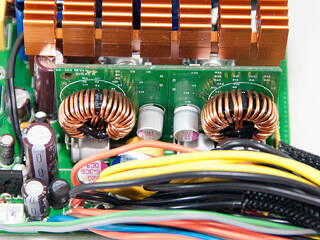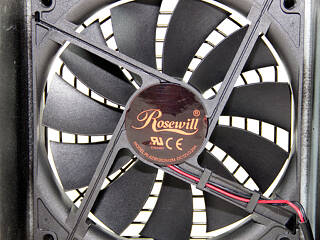 0
0
Rosewill Fortress 550 W Review
Voltage Regulation & Efficiency »A Look Inside
Before reading this page, we strongly suggest you take a look at this article, which will help you understand much better the internal components of a PSU.The OEM of all Fortress units is ATNG, a manufacturer that we seldom hear about but still has some rather interesting platforms to exhibit. When we remove the top part of the case, we can see a really small PCB which could easily be housed in a much smaller casing. Nevertheless, Rosewill most likely wanted to use the same thing for all Fortress units. This PSU uses a modern platform to achieve Platinum-level efficiency, since on the primary side we can see an LLC resonant converter, while on the secondary side, two DC-DC converters generate the minor rails and the +12V rails are rectified by mosfets (active or synchronous rectification).
Behind the AC receptacle is a small PCB housing many transient filtering components such as two pairs of X and Y caps, as well as a CM choke.
The transient filter continues on to the main PCB with two additional pairs of X and Y caps, a CM choke, and an MOV which, strangely enough, is located after the bridge rectifier and the PFC input cap.
The single-bridge rectifier is bolted onto the main heatsink.
In the APFC, a single FET, most likely a IPW60R190CP, separates the intermediate DC voltage coming from the bridge rectifier into constant pulse sequences and a boost diode (CREE C3D06060) boosts the pulsating rectified mains up to a loosely regulated ~380 V DC bus voltage. The single hold-up cap is provided by Nichicon (400 V, 330 µF, 105°C). As main switches, two IPW60R190CP transistors are used.
The PFC controller is installed on this small vertical daughterboard and its model number is CM6502S.
The two orange caps along with the inductor hidden under the main heatsink are the main parts of the LLC resonant converter.
The standby PWM controller is an STR-A6059H IC.
On the secondary side, the +12V rail handles four IPP041N04N FETs. Moreover, two DC-DC converters generate the minor rails from +12V. At each VRM, we find a dedicated PWM controller and two FETs.
On the secondary side, mostly polymer caps are used, all provided by Capxon except one made by Teapo; we can also see some Nippon Chemi-Con electrolytic caps rated at 105°C (KY series).
Soldering quality on the main PCB is not that good, especially on the secondary side where there are many ugly and blobby solder joints. These solder joints may have no effect on the performance of the unit, but, definitely, they are unsightly for a reviewer. On this side, the LLC resonant controller is also soldered, a CM6901 IC.
The cooling fan carries Rosewill's logo, but its model number, RL4Z-B1352512M (12 V, 0.28 A), reveals its real OEM which is Globefan. It uses double ball bearings, so it will last quite long and is very quiet at all times, as we have discovered during our test sessions.
Mar 10th, 2025 18:26 EDT
change timezone
Latest GPU Drivers
New Forum Posts
- RX 9070 availability (170)
- Msi 5090 DOA? (29)
- Biostar RX 6700 XT OC BIOS (1)
- Wherein lies the difference (1)
- Maxsun RX580 graphics card crashes (30)
- Gaming PC instabiliity (21)
- USB hard disk box capacity limits (12)
- Please I need help with the poor performance that my PC is giving me (32)
- I'm looking for a good tool to make the 3D scanning of my mini-pc using the photogrammetry and my Kinect 2. (53)
- What is a good real price for the RTX 5090? (23)
Popular Reviews
- Sapphire Radeon RX 9070 XT Nitro+ Review - Beating NVIDIA
- XFX Radeon RX 9070 XT Mercury OC Magnetic Air Review
- ASUS Radeon RX 9070 TUF OC Review
- MSI MAG B850 Tomahawk Max Wi-Fi Review
- NVIDIA GeForce RTX 5080 Founders Edition Review
- NVIDIA GeForce RTX 5070 Founders Edition Review
- Corsair Vengeance RGB CUDIMM DDR5-8800 48 GB CL42 Review
- AMD Ryzen 7 9800X3D Review - The Best Gaming Processor
- ASUS GeForce RTX 5070 Ti TUF OC Review
- MSI GeForce RTX 5070 Ti Gaming Trio OC+ Review
Controversial News Posts
- NVIDIA GeForce RTX 50 Cards Spotted with Missing ROPs, NVIDIA Confirms the Issue, Multiple Vendors Affected (513)
- AMD Plans Aggressive Price Competition with Radeon RX 9000 Series (277)
- AMD Radeon RX 9070 and 9070 XT Listed On Amazon - One Buyer Snags a Unit (261)
- AMD RDNA 4 and Radeon RX 9070 Series Unveiled: $549 & $599 (260)
- AMD Mentions Sub-$700 Pricing for Radeon RX 9070 GPU Series, Looks Like NV Minus $50 Again (248)
- NVIDIA Investigates GeForce RTX 50 Series "Blackwell" Black Screen and BSOD Issues (244)
- AMD Radeon RX 9070 and 9070 XT Official Performance Metrics Leaked, +42% 4K Performance Over Radeon RX 7900 GRE (195)
- AMD Radeon RX 9070-series Pricing Leaks Courtesy of MicroCenter (158)





























